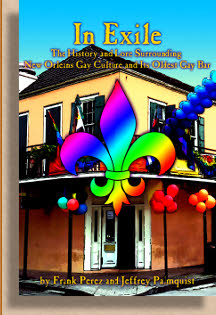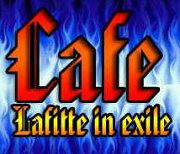

Site, content, and design © LL-



[From the Introduction by Frank Perez]
It is early Saturday morning. As day gradually usurps night, I sit pensively in Jackson Square. The cobblestone banquettes are shiny with wet for the street cleaners have just made their rounds washing away the remains of yesterday. Nearby a few homeless people sleep on benches sitting upright while a pigeon or two search in vain for crumbs. For the most part, the Square is empty, save a few faithful awaiting early morning mass. A family of tourists ambles by with their luggage. In the corner, a fortune teller shuffles her tarot cards. An old man walks his dog. The stench of trash fills the air as a garbage truck shares the streets with several produce delivery trucks bringing what will be, in a few hours, brunch. A strong breeze from the river is blowing.
The Cathedral bells ring and about two-
After the Mass has ended, I sit in the Square chatting with an ancient nun, dressed
in full pre-
Many words come to mind when one thinks of “New Orleans” but my favorite is mélange, a word that comes to us from the seventeenth century French word mêler, which means “to mix and mingle” and which has its etymological roots in the Old French word mesler, which in the Renaissance was a euphemism for sexual intercourse. Yes, mélange is the perfect word to describe New Orleans for what else is this city but a multicultural orgy producing a linguistic, ethnic, culinary, musical, and architectural fusion—disparate histories and cultural traditions melding, blending, coalescing, uniting, yet each one never quite losing its own identity. Ezra Pound might call it the urban embodiment of vorticism.
These thoughts are heavy, too heavy to bear without coffee so I walk a block to Café du Monde. Abandoning medieval French etymology, my mind turns to chicory. Chicory is a staple ingredient in virtually all New Orleans coffee. A derivative of the endive plant, chicory has been a coffee additive (and sometimes a substitute) for centuries. The chicory flower is thought to be the inspiration of the Blaue Blume, a central symbol in German Romanticism that represents desire and metaphysical yearning for the unattainable and the infinite—two universal concepts at the heart of Romanticism and essential to any brand of hedonism. No wonder New Orleanians love chicory!
The chicory’s stimulating quality casts a spell on me and I consider the Blaue Blume in terms of the mystery of sexual identity. What makes the intersection of sexuality and the urban space we call New Orleans so unique, so electric, so free?
Something about New Orleans renders difference irrelevant, makes it melt. Melt is a good word to describe the Quarter. Everything seems to melt here: cares, worries, inhibitions. Especially inhibitions. A prominent nineteenth century nun observed in a letter to her family back in France, “The Devil here possesses a large empire.” But not just morality, other things melt too: cultures, ethnicities, architecture, cuisine, music, languages. And sexualities. It’s not so much evanescence but rather mutability, a melting into each other, like the outlying marsh and swamp where land melts into sea. History melts too, if we let it.
Four hours after his first arrival in New Orleans, Tennessee Williams wrote in his journal, “Here, surely, is the place I was made for.” It is likely that his first sexual experience with a man occurred a few nights later. Williams would later call New Orleans his “spiritual home” and the French Quarter “the last frontier of Bohemia.” As he once wrote to a friend, “Town is wide open.”
Wide open indeed. Never burdened by the Puritanical baggage that straddles so many
other American cities, New Orleans has always enjoyed a certain permissiveness. Hedonism
permeates the air, so to speak. The city’s history and reputation for letting the
good times roll is well documented: Storyville and its hookers, jazz-
Despite the progress made in recent years, much of American gay history remains in the closet. This is certainly true of New Orleans. And that’s a shame. After all, New Orleans, throughout its colorful and picaresque history, has inspired and offered refuge to multitudes of gay writers, artists, musicians, and philanthropists. At some point during their time in New Orleans, each one of them, along with thousands of anonymous others undoubtedly darkened the door of America’s oldest gay bar—Café Lafitte in Exile.
In Exile: The History and Lore Surrounding America’s Oldest Gay Bar is an effort
to shed light on gay New Orleans hidden past. Much of that history was written by
firelight in a small bar on the quiet end of Bourbon Street. Known to regulars simply
as “Lafitte’s,” this bar served as the epicenter of gay life in New Orleans for decades.
And it’s still going strong. Drawn primarily on the recollections of those who patronized
the bar over the last fifty years, here are the stories of countless gay lives: bartenders
and hustlers, drag queens and closet cases, literary giants and movie stars, people
like you and me. Read and then close your eyes and re-
In the process, succumb to New Orleans’ inevitable charm. Join the multitude of scores who have made William Faulkner’s description of New Orleans ring fabulously true:
A courtesan, not old and no longer young, who shuns the sunlight that the illusion of her former glory be preserved. The mirrors in her house are dim and the frames are tarnished; all her house is dim and beautiful with age . . . those whom she receives. . . come to her through an eternal twilight . . . New Orleans . . . a courtesan whose hold is strong upon the mature, to whose charm the young must respond. And all who leave her. . . return to her when she smiles across her languid fan . . . New Orleans.
Faulkner’s description could easily be applied to Café Lafitte in Exile.
IN EXILE
The History and Lore Surrounding New Orleans
Gay Culture and Its Oldest Gay Bar
By Frank Perez & Jeffrey Palmquist
“A true look into New Orleans Gay History and Café Lafitte’s role in it.”
—Ken GranPré, General Manger Wood Enterprises, Café Lafitte
“Even further back than the oldest gay publication in the South, an exciting read...”
—Ambush Magazine
In Exile: The History and Lore Surrounding New Orleans Gay Culture and Its Oldest Gay Bar is the first comprehensive treatment of the history of gay New Orleans. Drawn primarily on the recollections of dozens of gay men and women, Frank Perez and Jeffrey Palmquist weave a fascinating narrative of how gay New Orleans evolved throughout the twentieth century.
In addition to showing the incredible and previously unrecognized contributions gay
people have made to New Orleans culture, In Exile also illuminates the darkness in
which ordinary gay people lived secret double-
Written with graceful insight and thoughtful perception, In Exile is not only a captivating history book, it is also a beautiful meditation on the intersection of place and identity.
[From the section: “A Mutual Affinity”]
New Orleans is a Siren City that smiles on all who visit her. She takes you in her arms and willfully gives up her secrets as she whispers in your ear, “It’s okay. I’m not perfect either. Look at my scars and wounds and wrinkles. Let’s forget the past with all its pain and live in the now. Come dream with me.”

Frank Perez -
Jeffrey Palmquist -
In Exile is also available from Amazon, Amazon Kindle, Barnes and Noble, OmnLit, and other online retailers.







